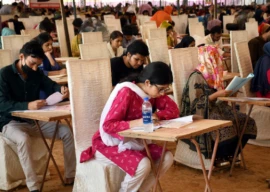
These findings for rural Punjab were reported by Annual Status of Education Report (ASER) 2016 during a ceremony held at a local hotel on Tuesday.
Punjab education budget increases by 10 %
The report is Pakistan’s largest annual citizen-led household survey and the seventh iteration. ASER is managed by Idara-e-Taleem-o-Aagahi (ITA) in partnership with many key social activists and semi-autonomous bodies, including the National Commission for Human Development (NCHD), DCHD, HANDS, HDF, Hamza Development Foundation, Centre for Governance and Public Accountability (CGPA), EHED Foundation etc.
For the year 2016, the ASER rural survey was conducted in 35 rural districts of Punjab, wherein 15,866 children between 5 and 16 years of age were tested for English, Urdu and arithmetic competencies. As many as 2,100 volunteer citizens, who personally visited 20,610 households in 1,035 villages/blocks, have based the ASER survey findings on the information of 59,311 children between three and 16 years of age. Around 45% of them were girls.
A total of 1,020 government schools, 48% primary, 22% elementary, 28% high, 3% others were surveyed. From private schools, 681 were surveyed of which 23% were primary, 52% elementary, 24% high and 1% others. Of the total, 44% of government schools were boys only, 21% were girls only, and 35% were coeducational schools. In case of private schools, 7% were boys only, 3% were girls only and 90% were coeducational.
According to the finding of the report, the proportion of the out-of-school children had decreased as compared to 2015. In 2016, 14% of children were reported to be out-of-school, up from 15% in the last year. A total of 7% children have never been enrolled in a school and 7% have dropped out of school for various reasons.
A total of 86% of all school-aged children between the ages of 6 and 16 years were enrolled in schools. Among these, 67% were enrolled in public schools, whereas 33% were going to non-state institutions. Around 30% went to private schools, 1% to madrassah and 1% to other institutes. Among the enrolled students in both government schools as well as private, 43% were girls and 57% were boys.
However, the report showed that the proportion of enrolled children has decreased in the early childhood programmes as compared to 2015.
A total of 51% of all school-aged children within the age bracket of three to five years were enrolled in schools as compared to 53% in 2015. Around 49% of children aged between three and five were currently not enrolled in any early childhood programmes.
The report further showed that learning levels of children had deteriorated. It found that 35% of class 5 children could not read a class 2 story in Urdu compared to 30% in 2015. Similarly, 72% of class 3 children could not read a story in Urdu, an improvement from 73% in the previous year.
Quality learning: Punjab remains committed to education
English learning levels have also deteriorated with 43% of class 5 children not being able to read sentences of class 2, compared to 40% in 2015. The report revealed that 77% of class 3 children could not read class 2 level sentences as compared to 80% in the previous year. Arithmetic learning levels have shown slight improvement as 40% of class 5 children could not do two-digit division as compared to 41% in 2015. At the same time, 77% children enrolled in class 3 could not do two-digit division in 2016 as compared to 82% in 2015.
The report found that children enrolled in private schools were performing better than their government school counterparts in terms of language. A total of 68% children enrolled in class 5 in a private school were able to read at least one story in Urdu as compared to 65% of class 5 children enrolled in government schools.
In terms of English learning levels, 62% of private school children were able to read sentences in class 5, whereas only 55% of government school children could do the same. Similarly, in arithmetic, 60% children enrolled in private schools (class 5) were able to do division compared to 60% class 5 children at government schools.
The report also showed that the gender gap continues in rural Punjab with boys outperforming girls in literacy and numeracy skills. The report found that 51% of boys and 48% of girls could read sentences in Urdu.
Published in The Express Tribune, September 14th, 2017.

1726117332-0/Megan-Thee-Stallion-(1)1726117332-0-165x106.webp)





















COMMENTS
Comments are moderated and generally will be posted if they are on-topic and not abusive.
For more information, please see our Comments FAQ